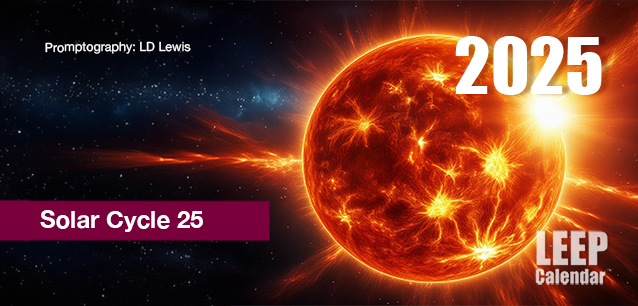 AD
AD
Today is: December 05
Scroll to explore events active on this date.
LEEP INK FEATURES

August? Absolutely!
In August, we live through the Dog Days of Summer. It's hot and often humid, and those who can leave for better climates do. Down south, winter is in full force. August is also known as "the ...

In The Heat of July: July 2025 Events
Is it hot enough (or cold enough if you're below the equator) for you yet? There is actually a day for that! Like every month, I pick a diverse collection of events you may or may not know about. This ...

May Blooms: Events in May 2025
Along with October, May is one of the most densely packed months of the year. It's before the summer humidity and the last whole month of the school year. The weather is warming in t...
About the Solar Cycle 25 in 2025
Ends: Dec 31, 2025
DESCRIPTION:
SOLAR CYCLE 25 PEAKS:
WHAT TO EXPECT IN JULY 2025
Solar Cycle 25, which began in December 2019, is expected to peak around July 2025. This period of heightened solar activity brings a range of impacts on Earth, driven by solar storms and other space weather phenomena. Understanding and preparing for these effects is crucial for businesses and individuals.THE NATURE OF SOLAR CYCLE 25
Solar cycles last approximately 11 years and are marked by the activity in the Sun's fluctuations. These cycles are characterized by the number of sunspots and dark regions on the Sun's surface, indicating areas of intense magnetic activity. Solar Cycle 25, following a relatively quiet Solar Cycle 24, is anticipated to be more active, with an increase in solar flares, coronal mass ejections (CMEs), and other solar phenomena.IMPACT OF SOLAR STORMS AND SPACE WEATHER
Solar storms, caused by CMEs and solar flares, can have significant effects on Earth:
Geopolitical and Technological Impact—Solar storms can disrupt satellite communications, GPS systems, and power grids. In extreme cases, they can cause widespread blackouts and damage to infrastructure.
Aviation and Space Travel—Increased solar activity poses risks to astronauts and high-altitude flights, exposing them to higher radiation levels.
Radio Communication—HF (high frequency) radio communications can be severely affected, impacting aviation, maritime operations, and emergency services.
Auroras—One of the more visually striking effects is the intensification of auroras, visible at lower latitudes during significant solar storms.WHAT TO EXPECT WITH INCREASED SOLAR ACTIVITY
As Solar Cycle 25 intensifies, we can expect more frequent and stronger solar storms. This heightened activity will likely lead to:
Increased Frequency of Auroras—More opportunities to witness the Northern and Southern Lights.
Disruptions in Technology—Greater potential for interruptions for GPS, communications, and power systems.
Higher Radiation Levels—Increased risks for astronauts and passengers on high-altitude flights, particularly over polar regions.PRECAUTIONS FOR BUSINESSES AND INDIVIDUALS
Several precautions can mitigate the effects of increased solar activity, including:
Infrastructure Protection—Power companies can install protective devices and protocols to manage grid stability during solar storms.
Satellite Shielding—Operators can design satellites with shielding to protect against solar radiation and ensure redundancy in critical systems.
Communication Plans—Businesses and emergency services should have contingency plans for communication disruptions.
Awareness and Monitoring—Individuals and businesses should stay informed about space weather forecasts to avoid potential impacts on technology.FREQUENCY OF INTENSE SOLAR CYCLES
Solar cycles vary in intensity. Historically, more intense cycles occur approximately every 22 years, with the Hale cycle, a magnetic cycle of the Sun lasting about 22 years, influencing the intensity of solar activity. The last notably intense cycle was Solar Cycle 23, which peaked around 2000. Comparatively, Solar Cycle 24, peaking around 2014, was relatively mild.
As Solar Cycle 25 peaks in July 2025, the increased solar activity will significantly impact technology, aviation, and daily life. Understanding these effects and preparing can help mitigate risks and capitalize on opportunities, such as enhanced aurora visibility. Staying informed and taking proactive measures will be vital in navigating the challenges of the heightened solar activity.
VIDEOS
SUPPORTING DOCUMENTS
Currently, this event does not have supporting documents.
ADDITIONAL IMAGES
Currently, this event does not have supporting images.
Where would you like to go now?
 AD
AD


/footer-logo.svg)
